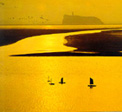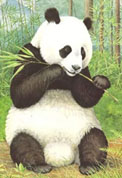| |
| National
People's Congress (NPC) |
|
| |
| In
East Asia, by the west Pacific Ocean. |
|
| |
| 9.6
million square km, second to Russia and Canada. |
|
| |
|
|
|
| |
|
| |
| 39.8 trillion yuan (US$6.15 trillion) at the end of 2010. |
|
| |
| |
|
High
in its west and low in its east: mountain areas 33.3%, plateaus
26%, basins 18.8%, plains 12% and hills 9.9%. |
|
| |
| Among
the 5,400 islands, Taiwan Island (about 36,000 square km) is
the largest, Hainan Island (about 34,000 square km) the second.
|
|
| |
 Himalayas
Himalayas
|
|
Among
the 19 mountains over 7,000 meters high in the world, seven
are in China. The Qinghai-Tibet Plateau, known as "the roof
of the world", has many high mountains. The Himalayas, with
an average elevation of 6,000 meters, have the world's highest
peak Mount Qomolangma, 8,844 meters above sea level.
|
|
| |
 Yangtze
River
Yangtze
River
|
|
The
Yangtze River, 6,300 km long, the third longest in the world
after the Nile and the Amazon. The Yellow River, the second
longest in China, stretching 5,464 km. |
|
| |
| The
canyon on the Yalu Tsangpo River, the world's largest, 504.6
km in length and 6,009 meters in depth. |
|
| |
 Grand
Canal
Grand
Canal
|
|
The
Grand Canal, 1,801 km long, the longest man-made river in the
world. Its cutting began in the fifth century BC.
|
|
| |
 Poyang
Lake
Poyang
Lake
|
|
The
Poyang Lake on the middle and lower reaches of the Yangtze River
is China's largest freshwater lake; the Qinghai Lake on the
Qinghai-Tibet Plateau, the country's largest salt lake. |
|
| |
| Most
of the country in the temperate zone, although geographically
the country stretches from the tropical and subtropical zones
in the south to the frigid zone in the north.
|
|
| |
 Giant
Panda
Giant
Panda
|
|
China
has a great variety of wildlife, over 4,400 vertebrates, more
than 100 rare species of the world: the giant panda, the golden
monkey, the white-lipped deer, the South China Tiger, Crossoplilon
mantchuricum, the white-flag dolphin, the Chinese alligator,
and the crowned crane. |
|
| |
| China
has a great variety of plants, 32,000 species of higher plants,
including nearly all the major kinds of vegetation found in
the frigid and temperate zones of the northern hemisphere.
|
|
| |
| Peony,
azalea, primrose and felwort. |
|
| |
| 1.37 billion by the end of 2010 (including Hong Kong, Macao and Taiwan) |
|
| |
|
| |
| 73.5 years old by the end of 2009 |
|
| Mainland Population
composition |
|
 |
|
| The males: 51.27%, the females: 48.73%; people aged 0-14: 16.60%, people aged 15-59: 70.14%; people aged above 60: 13.26%; urban population: 49.68%, rural population: 50.32%. |
|
| |
| China has 56 ethnic groups, of which the Hans have the largest population, accounting for 91.51 percent of the total, according to the country's sixth census conducted in 2010. The other 55 ethnic minority groups account for 8.49 percent. |
|
| |
| Of
the 56 ethnic groups in China, the Hui and Manchu use the same
languages as Han people, while the rest of groups have their
own spoken and written languages. |
|
| |
| China’s 11 public holidays include: New Year's Day (January 1); Spring Festival – a holiday of several days duration starting from the eve of the Lunar New Year through the second day of the Lunar New Year; Qingming Festival on April 5, known in English as Tomb Sweeping Day; International Labor Day on May 1; the Dragon Boat Festival, held on the fifth day of the fifth lunar month; the Mid-Autumn Festival, held on the 15th day of the eighth lunar month; and the National Day holidays – the first three days of October. |
|